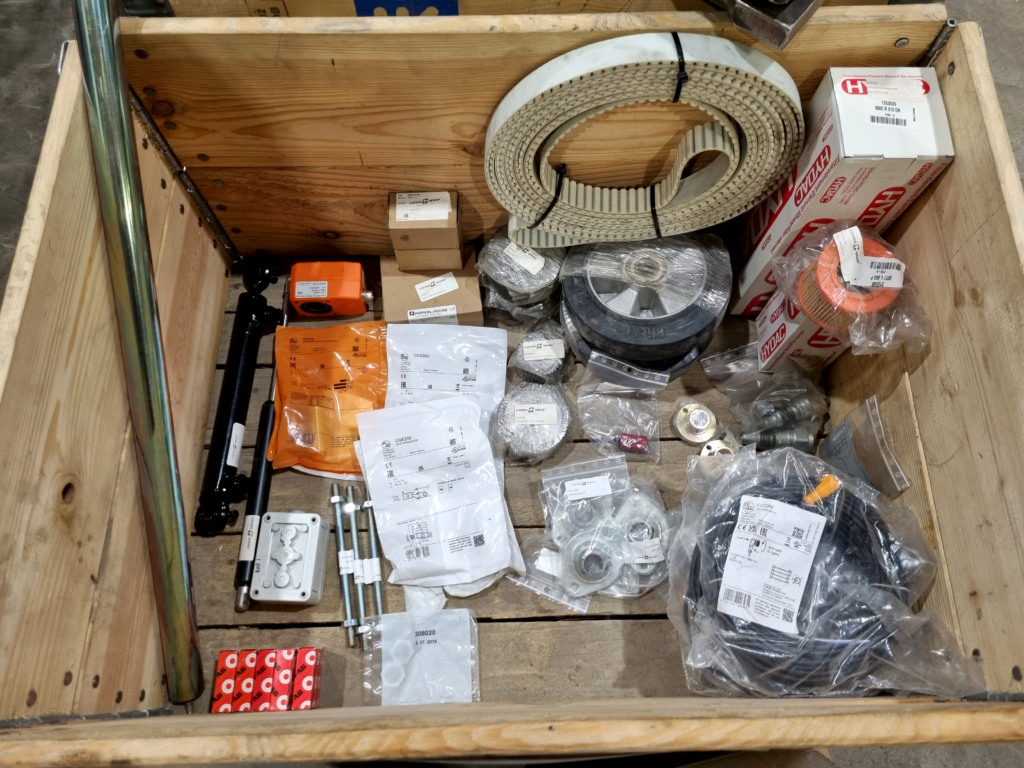Blog
Relocating a Cross Wrap Bale Wrapper: lifecycle services at Svalbard
Relocating a Cross Wrap Wrapper: lifecycle services at Svalbard
Cross Wrap’s machinery is delivered and installed all around the world. After the delivery our aftersales team continues to take care of our customers, ensuring reliable operations by offering the best possible solutions and support for our machines.
In our previous blog we introduced the northernmost delivery of a CW Direct Bale Wrapper to Svalbard island. After the 5 years of successful RDF bale wrapping process, it was the time for them to move to a brand-new waste treatment facility. In collaboration with Norwegian company Steco Miljø, Cross Wrap took part in this process. In this blog, we are taking our readers into the world of aftersales services on example of transferring a Bale Wrapping machine to another location in Svalbard.

Machine relocation is a common procedure for Cross Wrap engineers
The northernmost aftersales services
For Ilya Chiksoev, this was his northernmost commissioning inspection visit. “The purpose of the trip was to move our Direct wrapping machine, which was delivered to its original site about 5 years ago, to the new facility. Our old partner Steco Miljø, who was the turnkey supplier for the new site, ordered our commissioning services. Cross Wrap provided our partner with all electrical drawings and installation photos for the sufficient machine transfer and my part in the process was to do the monitoring, maintenance and update the machine’s new parameters”, Ilya tells.
Longyearbyen the largest city on the Svalbard islands with a population of approximately 2200 people and 1 waste treatment station. The town is very small, and everything is very close. ”The old facility was built is 1990s, when Svalbard only had half of the current population. Due the increase in tourism and the amount of waste, we needed a bigger and modern waste treatment facility which has been placed 3 km away from the old one”, tells Karine Hauan, the leader of the waste management department in Svalbard.
“During these 4 days when were booked for the commissioning I checked the machine’s installation and the functionality of the conveyors. Together with Steco Miljø we did test runs of the whole line including waste bale wrapping process. Nothing exceptional was found during the inspection and the machine was adjusted according to the customer’s needs. Also, some parameter configuration changes were made for the storage conveyor due the relocation and small changes in the customer´s machine layout”, Ilya explains.
Svalbard’s waste treatment
Svalbard’s waste treatment system is more restricted compared to the Norwegian system on the main land. It is prohibited to have any of recycling operations outside of the Longyearbyen waste treatment facility, to ensure that not even piece of garbage will get away to the nature. “It is the only closed operating facility in Norway. The waste handling regulations on the island became more precise which makes the government’s monitoring easier”, says Karine Hauan.

Svalbard’s thorough waste management system ensures that no garbage ends up in the archipelago’s nature
Similarly, as in mainland, Svalbard households and the local enterprises are sorting cardboard, general waste, metal, and glass before the collection. However, there are no separate bins for the household’s plastic waste yet. “The household’s plastic waste is usually not very clean, and it must be burned anyway, but we are sorting a clean plastic waste which comes from the local enterprises. There is more space for the containers and a possibility for sorting at the new waste treatment station. In the future, we may also look at the possibility to have our waste to energy facility, but at the moment we produce only 2000 tons of waste in a year, which is more reasonable to ship to the mainland”, Karine Hauan tells.
The material that goes into the bale wrapping process is pretty hard, especially when it comes to construction waste, wooden boards, and chipboards. That’s why a new modern crusher was also purchased for the new station. “The new crusher grinds waste better, and more material is pressed into one bale. Now it is possible to wrap up to 800 kilos per bale instead of 600 kilos and to fit more RDF materials into the containers. These containers will be delivered to the nearest port of Tromsø and transported to the waste-to-energy facility to produce heat to the city”, Ilya says.
Machine transferring is a common procedure
Machine transfer projects are quite common procedure for Cross Wrap engineers. “Customers’ needs and processes may change sometimes – machines change owners or need to be transferred to the new facilities, and sometimes there are some changes in the layouts due to modifications of the lines.”
Cross Wrap’s transferring and commissioning services guarantees our customers the certainty that the machine will start to run the way it should after the changes in its location.
“Machine transfer service has been customized in a way that we can estimate the time it takes for each type of machine transfer. When we have the maintenance contract with the customer, we can follow the maintenance history of the machine and evaluate the machine’s condition. All this information supports our engineers to count a certain schedule for the process, calculating the workload for transfer and commissioning, and calculating the price for this service. Cross Wrap’s transferring and commissioning services guarantees our customers the certainty that the machine will start to run the way it should after the changes in its location. For example, Svalbard’s wrapper’s transfer seemed pretty simple: the same machine’s installation with the same dimensions, but after some changes in the layout, it would still require a commissioning professional’s supervision. After adjusting the new parameters machine was running as it should and the users were completely satisfied with the quality of the work”, Ilya tells.
A proper arrangement of lifecycle services
The machine’s condition was checked at the same time as well as the machine’s maintenance. The oil and filters were changed and the plastic cover boxes for the roll holder stretching units were installed, so the customer does not need to worry about the small details. The report of the commissioning and the list of spare parts will be also provided to the customer.

Thorough preparation and risk assessments make long-distance commissioning trips more efficient for Cross Wrap and our customers
“When we are planning this kind of projects for our distantly located customers, we need to forecast the spare parts which could be used for machine’s successful installation and commissioning after the transfer. The customer received spare part package in advance. We also need to be prepared for the possible damages which can occur during the transferring process. I took some electrical cables and a few critical sensors with me on the trip. The lack of these small critical spare parts would affect negatively on the installation and commissioning processes. For example, in a such a distant place as Svalbard the local availability of components is quite poor. The existence of spare parts packages with the right components shipped and delivered in the right time is emphasized. It also requires from the Cross Wrap’s aftersales team a proper arrangements and forecasting”, Ilya explains.
“When one of the sensors was broken, it was very helpful to have the right one with me, otherwise, the trip would be wasted. These are the small details that our customers don’t have to understand, it is Cross Wrap’s field of expertise and risk situations evaluation.”
A great collaboration brings a great result
“In general, I am very satisfied with the collaboration with Svalbard’s waste management department and our partner Steco Miljø. The project was completed on time. Svalbard’s views were spectacular, and the people were kind. I did enjoy my time being on the island despite the fact I didn’t meet a polar bear,” Ilya finalizes his story.
”We were very satisfied with Cross Wrap’s service’s quality. It was nice to have someone who really knows the machine! The benefits coming from the baling and wrapping process are the clean waste handling process and efficient transportation and storage of waste bales. These are the main points why we are shipping our waste baled and wrapped”, Karine Hauan finalizes.

“Svalbard’s views were spectacular, and the people were kind”, comments Customer service manager Ilya Chiksoev
Benefits achieved at Svalbard Direct wrapper’s machine relocation
- Collaboration with partners. Providing all required machine documentation in time
- Machine installation inspection
- The machine was adjusted according to the customer’s needs
- Extensive experience in the machine transfer process
- The certainty in the machine’s functionality
- Condition of the machine was checked
- Flexibility and extra services, e.g. machine maintenance
- Monitoring the entire installation
- Certain schedule for the certain machine type – service is customized
- Fixed price of service
- Anticipation for the spare parts which needed
- Possible damages anticipation
- Report and spare part recommendations
- Spare parts packages in time
- Careful preparation to the project insures successful commissioning
